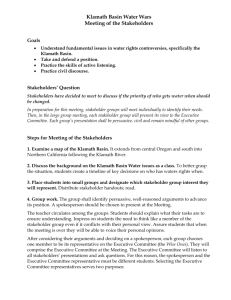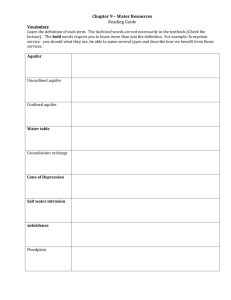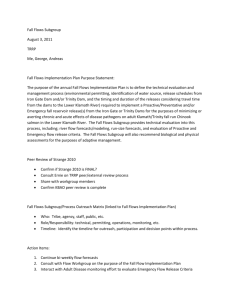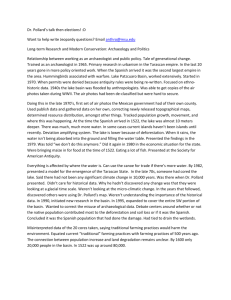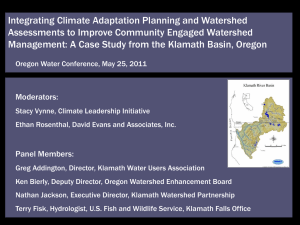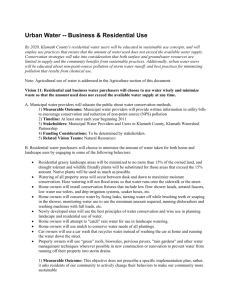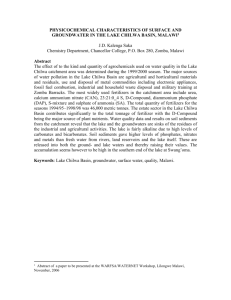Oregon Water Resources Commission
advertisement
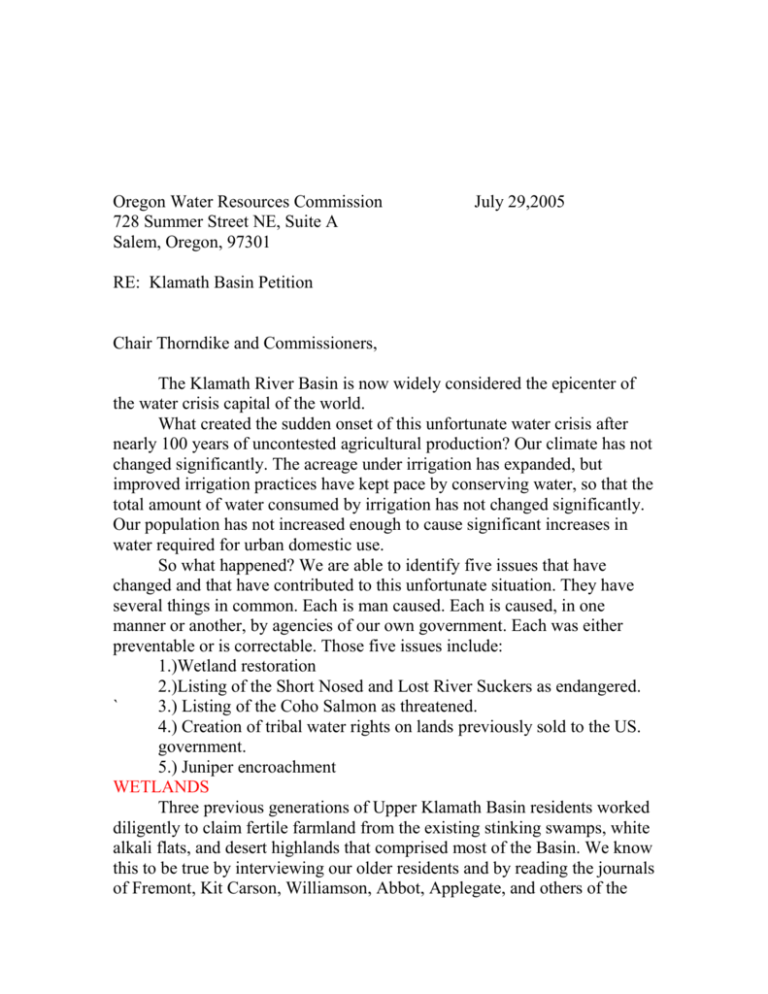
Oregon Water Resources Commission 728 Summer Street NE, Suite A Salem, Oregon, 97301 July 29,2005 RE: Klamath Basin Petition Chair Thorndike and Commissioners, The Klamath River Basin is now widely considered the epicenter of the water crisis capital of the world. What created the sudden onset of this unfortunate water crisis after nearly 100 years of uncontested agricultural production? Our climate has not changed significantly. The acreage under irrigation has expanded, but improved irrigation practices have kept pace by conserving water, so that the total amount of water consumed by irrigation has not changed significantly. Our population has not increased enough to cause significant increases in water required for urban domestic use. So what happened? We are able to identify five issues that have changed and that have contributed to this unfortunate situation. They have several things in common. Each is man caused. Each is caused, in one manner or another, by agencies of our own government. Each was either preventable or is correctable. Those five issues include: 1.)Wetland restoration 2.)Listing of the Short Nosed and Lost River Suckers as endangered. ` 3.) Listing of the Coho Salmon as threatened. 4.) Creation of tribal water rights on lands previously sold to the US. government. 5.) Juniper encroachment WETLANDS Three previous generations of Upper Klamath Basin residents worked diligently to claim fertile farmland from the existing stinking swamps, white alkali flats, and desert highlands that comprised most of the Basin. We know this to be true by interviewing our older residents and by reading the journals of Fremont, Kit Carson, Williamson, Abbot, Applegate, and others of the first European visitors to the Basin. All accounts agree that much of this Basin was unproductive, nearly uninhabitable, wasteland. Further, the waters of Upper Klamath Lake were considered unfit for consumption by livestock by the earliest European explorers. In fact, the stinking fetid brown water of the lake caused Applegate to bypass Upper Klamath Lake when developing the Applegate Trail. The current generation, under the guise of habitat restoration and environmental stewardship, seems determined to revert this fertile farmland to stinking swamps, white alkali flats, and desert highlands. Open water and emergent wetlands in the Upper Klamath Basin evaporate between 2.75 and 3.5 acre feet of water per acre annually. This is significantly more than the consumptive use by irrigated agriculture for any crop grown in the Basin under any current irrigation application management. Prior to the irrigation projects, more than 300,000 acres of shallow lakes and emergent wetlands evaporated more than 1 million acre feet of water annually. If restored to shallow lakes and wetlands, they will once again evaporate more than 1 million acre feet of water annually. The recently completed Bureau of Reclamation “Undepleted Flow Study” of the Upper Klamath Basin clearly substantiates this fact. This heavily peer reviewed study demonstrates that during dry years all the surface flows were evaporated seasonally causing the upper reaches of the Klamath River to go dry. As a direct result of the action of certain agencies of our government, the more than 90,000 acres of cropland and pasture already restored to wetlands are currently evaporating well over a quarter of a million acre feet of water annually. In a moderately dry year the entire Klamath Project uses less water than is currently being evaporated from these restored wetlands. The federal government is currently negotiating further major purchases to restore to wetland habitat. SUCKERS No one can seriously argue that the number of suckers did not significantly decline during the decades of the 70’s and 80’s.Their listing as threatened species may have been warranted in 1986 at the time the legal fishery for the suckers was finally closed. Listing them as endangered in 1987 was, and remains, unwarranted because either the counting methods were totally inaccurate at that time, or the species have experienced the most remarkable recovery imaginable. Biologists identified declining water quality in Upper Klamath Lake as the primary cause of the sucker’s impending demise. They declined to consider that water quality in Upper Klamath Lake was described as “too putrid to allow livestock to drink” as early as the late 1800’s by Fremont, Williamson, Abbot, Applegate, and others. In fact, geologically, Upper Klamath Lake has been a dying eutrophic lake for thousands of years. They further declined to label the sport fishery ongoing until 1986, and the presence of the Chiloquin dam that continues to block the suckers from some 90% of their historic spawning areas, as significant causes. Instead, they required screening of irrigation diversions that have been in service for nearly a century. They required maintaining higher lake levels that the National Academy of Sciences stated may actually cause worse lake water quality. These required minimum lake levels prevent more than 150,000 acre feet of water, stored in Upper Klamath Lake for irrigation purposes, from being delivered to the irrigators. The maintenance of minimum lake levels have not measurably changed the water quality of Upper Klamath Lake. COHO Wild Coho salmon, that were on sale for $2.99 a pound in the Salem Winco supermarket recently, have been listed as a threatened species for several years. Listing this species required some tortured logic. First, the Coho found in each river system were defined as Evolutionary Distinct Units of the species by virtue of their general instinct to return to the river where they were spawned. Defining a species by their instinct is definitely plowing new scientific terrain. Even then, the biologists ignore the fact that this instinct is not absolute, and that salmon often return to rivers other than where they were spawned. Second, hatchery raised salmon were defined as not real Coho, even though they have interbred with the wild salmon for more than 100 years, and are indistinguishable from the wild salmon by geneticists except for their markings made by man at the hatchery. Using similar logic, perhaps test tube babies are not real human beings. Third, they justified this definition by labeling hatchery-raised fish inferior to wild salmon in strength of instinct, predator avoidance, and disease resistance, even though no way exists to substantiate the label, or even to tell them apart except by man made hatchery markings. Further, they ignored the fact that the hatchery raised fish demonstrate the same instinct to return to the river of their origin as the so called native fish. Minimum Klamath River flows at Irongate Dam are now required to help maintain these threatened creatures, even though the National Academy of Sciences, as well as other knowledgeable fish biologist, believe that the seasonal increased flow of warm water from Upper Klamath Lake is actually harmful to the fish. Without the water impounded and stored for irrigation no water would be available to establish these increased flows.These increased minimum flows prevent another 150,000 to 200,000 acre feet of water, stored in Upper Klamath Lake for irrigation purposes, from being diverted to the irrigators. TRIBAL WATER RIGHTS IN 1864 the Tribes entered into a treaty in which they agreed to transfer their aboriginal claims to about 12 million acres to the United States government in exchange for a reservation of about 800,000 acres in the Upper Klamath Basin. After the Allotment Act of 1887 about 25% of that reserved land was transferred to individual tribal members. Over subsequent decades, much of this land owned by individual tribal members was sold to non-tribal members. Between 1954 and 1975 the federal government purchased, and now holds title to, all of the remaining tribal lands amounting to about 70% of the former reservation. In the original Adair case, the federal government sued the state of Oregon to establish federal water rights on the Upper Klamath Marsh Wildlife Refuge that it had purchased from the tribes in 1958. The federal government claimed that this flooding of the marshes would also act as irrigation storage for adjacent private land-owners. Because the private land owners believed that flooding the marshes would only evaporate much needed water, they contested the claim. The land owners’ beliefs were well founded. Currently, the tens of thousands of acres of flooded marshes have been determined to evaporate and evapo-transpire more than three-acre feet of water from each acre of their surfaces annually. The Klamath Tribes claimed that their aboriginal rights to water use necessary to support hunting, fishing, and gathering had not transferred to the federal government with the government purchase of the marsh-land, and also contested the claim. Their claim included reserved instream flows and Upper Klamath Lake minimum levels with a priority date of “time immemorial”. In the first Adair decision, a federal district court ruled that a water right was an inherent part of those retained rights, that those retained rights had not transferred to the government with their land purchase, and that the retained water right had an 1864 treaty established priority date of “time immemorial”. The federal court recognized its lack of jurisdiction and left to the state of Oregon the job of quantifying or adjudicating those retained right. Tribal claims to water in the Oregon adjudication are equal to virtually all of the tributaries to Upper Klamath Lake at historic high water mark flows, and to Upper Klamath Lake at elevation 4141 ft. above sea level. If granted, these claims would preclude all irrigation diversions above Upper Klamath Lake, and reduce deliverable water to the Klamath Project by approximately 200,000 acre-feet. The United States Supreme Court has ruled in a similar case, that the tribal water rights are limited to the amount they were actually putting to beneficial use at the time the tribal lands were sold. The Ninth Circuit Court of Appeals relied heavily on that opinion in deciding both of the Adair appellate cases. In contradiction to this principle, the United States Fish and Wildlife Service’s Biological Opinion requires minimum Upper Klamath Lake levels to be maintained to support the tribal claims for treaty reserved sucker habitat. JUNIPER ENCROACHMENT . Juniper trees consume between 8 and 50 gallons of water per day with a average 40-gallon consumption by mature trees according to the Natural Resources Conservation Service. This consumption rate means an average mature juniper tree will consume about 5 1/3 cubic foot of water per day. Assuming only a 120 day growing season, a mature juniper tree would consume about 640 cubic feet of water annually. Therefore, 70 mature juniper trees would use about an acre foot of water annually. Using the NRCS estimate of about 200 juniper trees per acre on average, this water consumption would then be estimated at about 3 acre feet per year for a juniper forest. SWCD estimates 300,000 acres of juniper “forest” encroachment in the Upper Klamath Basin. This amount of juniper encroachment would be estimated to consume as much as 900,000 acre feet of water annually, an amount equal to the entire outflow from the Upper Basin at the Keno Dam. The cause of this juniper encroachment is regularly debated. Some blame livestock grazing. Some blame over zealous fire control. Other causes are promoted. Whatever the cause, juniper encroachment is visible, measurable, and demonstrably harmful to the water budget of the Upper Klamath Basin. Juniper mitigation is a dynamic part of restoring the Basin to its former productivity. Government action directed at draining the wetlands, de-listing the endangered and threatened species, fairly adjudicating the tribal water claims, and removal of the juniper encroachment would soon re-establish an abundant flow of water available for irrigators in this basin. Instead, certain agencies of our government are creating more wetlands, creating ever more stringent water requirements for habitat restoration for endangered species, are negotiating with the Tribes to legitimize their unfounded Draconian claims for water, and refuse to even address the juniper encroachment issue. The basic issue in the Klamath Basin is the reallocation of water stored for irrigation to other purposes. Without that irrigation storage, stream flows would be minimal to non-existent during dry years. The Water Watch petition to withdraw the basin from further appropriation is unwarranted and ill founded because it does not attempt to address any of the causes of the issue. Instead, it seeks to blame the irrigation development and irrigation practices that actually sustain stream flows, wildlife refuges and habitat. Respectfully submitted, Senator Doug Whitsett Senate Room 302 900 Court Street Salem, Oregon 97301
